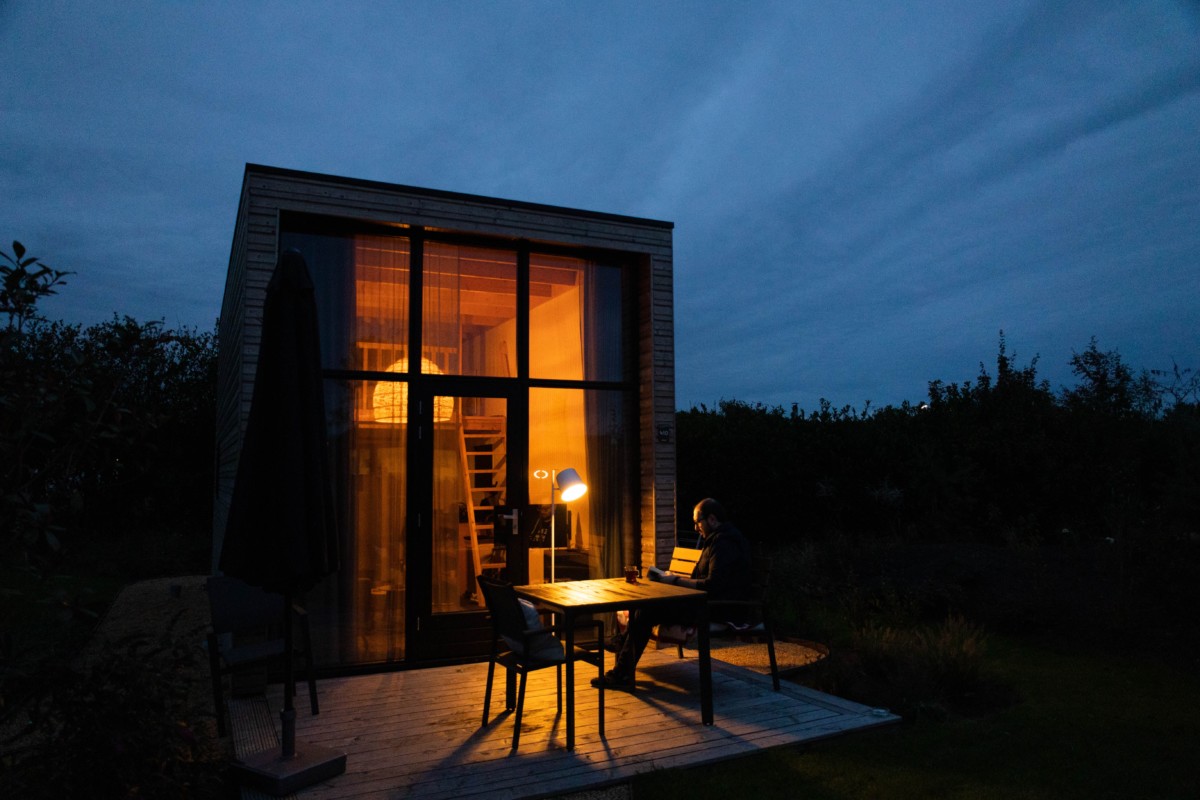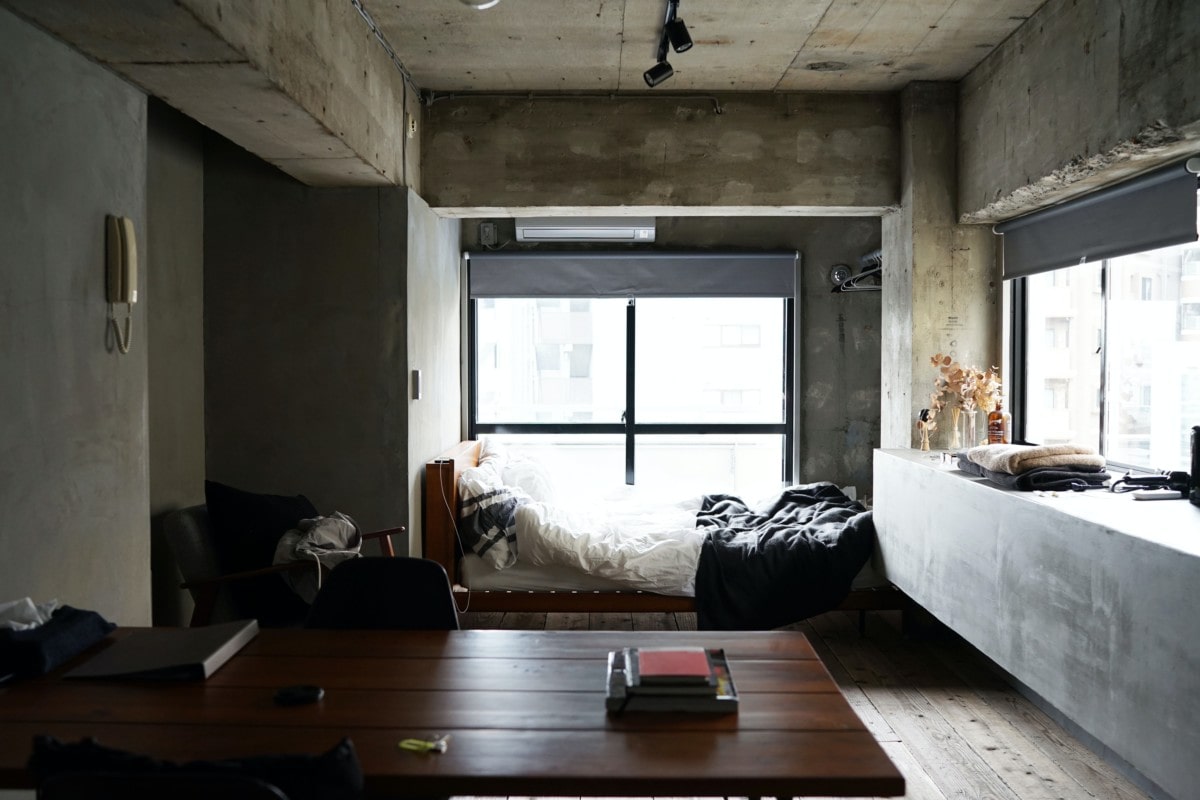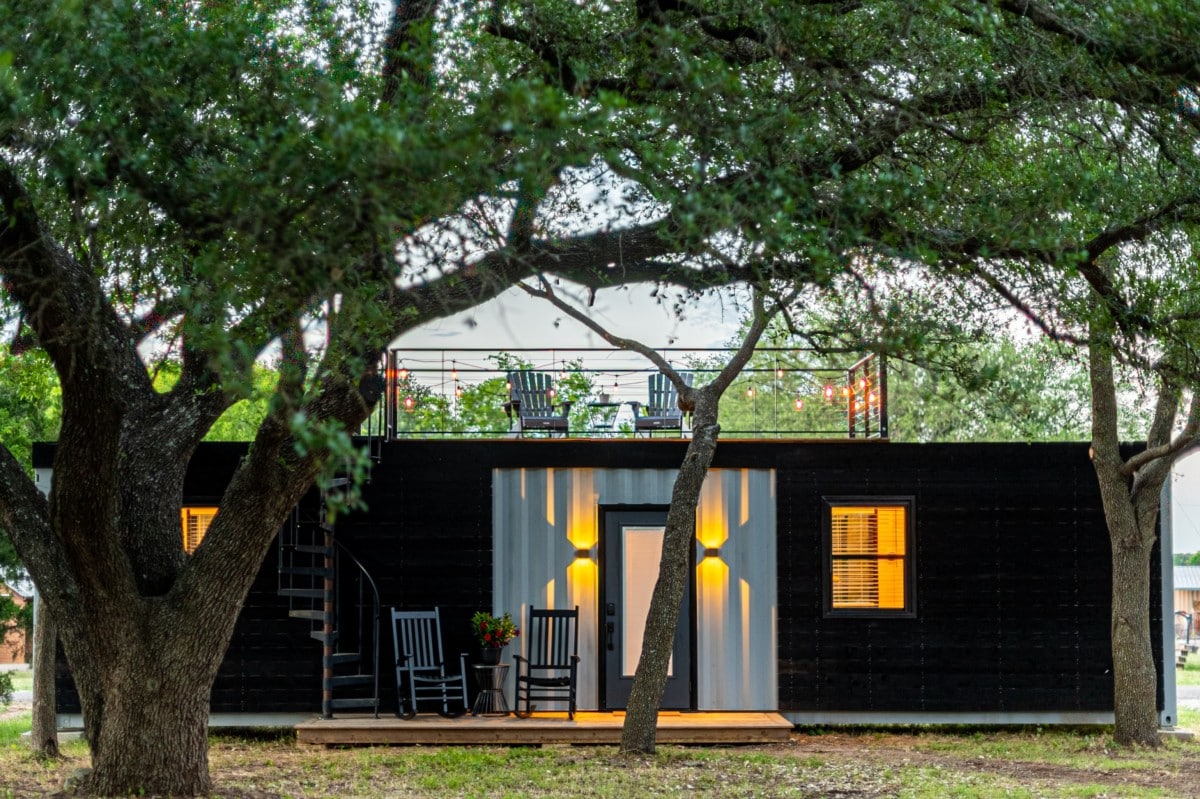The home we choose to buy has a significant impact on our lives. Do you buy a classic Cape Cod-style home? Maybe something more unique like a Victorian house? What about taking the leap and purchasing a tiny house? Purchasing a tiny home can be a great way to live more sustainably, cut down costs, declutter your life, and focus on what matters to you.
But what exactly does it mean to live in a tiny house? From the pros and cons of this minimalist lifestyle to the types of tiny homes available, here is what you need to know before deciding if tiny house living is right for you.

What is tiny house living all about?
The tiny house movement is an architectural and social movement that advocates for downsizing living spaces, simplifying, and essentially “living with less.” This modern lifestyle proves to be more than just living in a smaller house. The tiny house community can significantly impact one’s happiness, values, and compassion for the environment.
An estimated 2,000 to 5,000 tiny homes sell per year, ranging in size between 200 to 600 square feet. California, Oregon, and Texas are among the most popular states to build a tiny house. This is because there are many resources available for tiny home buyers in these states- like real estate agents, tiny home communities, and expert builders.
Types of tiny homes
Tiny houses come in all shapes, sizes, and forms. When choosing a tiny house, you’ll want to think about where you plan to place it. The type of tiny home you select will determine the type of land you can live on. Some choose to use a backyard space, rent a lot in a tiny house community, or opt for a home on wheels. Here are five of the different types of tiny homes you can find.
Shipping container homes
Made of durable material that is cost-efficient, container homes are among the most popular tiny houses available. Shipping containers offer a flexible open space that you can transform into a cozy abode. Because of their open layout, you can create your own unique space with innovative features such as multiple loft areas, opportunities for rooftop spaces, or a second floor.
Tiny house on wheels
Lots of tiny home dwellers opt for a tiny house on wheels because they are perfect for homeowners who want to travel. Many receive financial freedom from downsizing their living spaces, allowing them to spend more time on the road. The tiny home on wheels is also a great way to avoid permitting and zoning requirements.
Off-grid tiny cabins
Whether it’s for a permanent residence or weekend getaway, an off-grid tiny house is a great way to connect with nature and have some peace. Carole from Sustainable Living advises those with off-grid tiny homes too, “create a self-sufficient house. Optime solar power for energy generation, recycle rainwater for personal use and grow the food you need. It’s a budget-friendly, waste-free, and sustainable lifestyle.” Off-grid tiny homes will require knowledge on self-sufficient living, but learning this skill only benefits in the long run.
Tiny house in a tiny community
Another great thing about tiny house living is that there are numerous tiny home communities you can join. Placing your tiny house in a tiny home community allows you to live with like-minded individuals. Depending on your state’s zoning and permitting laws, this may be your only option. In addition, you can also anticipate a monthly cost for living in a tiny community. Depending on whether the community is on private or public grounds, the price ranges from $8.1k – $12k per year or $675 – $1k per month.
The backyard tiny home
Maybe you’re looking to increase the square footage of your single-family home. Adding a small space in the backyard can undoubtedly do that. You can rent the area, use it as a home office, or make space for a family member. Not every tiny home buyer is looking for a full-time experience – if that’s you, the backyard tiny home may be for you.
If you’re looking for a plot of land to place your tiny home, Michael Leigeber from Landsearch suggests looking into more rural options. “Rural land usually costs less and comes with fewer zoning and building restrictions,” says Leigeber. “Still, unrestricted land is rare, so choose your location carefully.” Keep in mind that you’ll need to check your state’s guidelines on tiny homes throughout this process.
This list of tiny home types is just a starting point. Before making any decisions, you should research what kind of home and layout suits you best; once you’ve done that, you can decide where to place your home.
Building a tiny house
Many tiny house dwellers are excited about the DIY aspect of tiny house living. DIY tiny home builders will spend between $8K and $30K building their tiny home. Professional-built tiny homes will range from $45K to $150K. This is a significant cost difference, but there are pros for having your tiny home built by a professional. Greg Klippenstien from Mountain West Tiny Homes says, “People want an inexpensive DIY tiny house but overlook the safety features of a certified tiny home built to national standards.”
Unless you’re highly skilled in DIY, working with a professional builder may be the right choice. Experts will turn your desires into reality while creating a comfortable, safe, and thought-out design. Experts know what you need, like Cordell Pollock from Vedahawk Tiny Homes, who notes, “Spend the money on heating and insulation. This includes a full thermal break, spray foam insulation, and a hydronic in-floor heating system.”
If you’re still considering DIYing your tiny house, consult with experts before you begin your build. David and Lizzie from Omni Tiny Homes say, “Building and creating your shelter is one of the greatest accomplishments – tiny houses make this achievable for more people. We do still stress the importance of consulting with qualified builders, electricians, and plumbers during the process”. You want your tiny house to function just like a regular house. Working with professionals will elevate your space.
Pros to tiny house living
Living in a tiny house has numerous advantages. Here are a few reasons to start your tiny home journey today:
Sustainability
Tiny houses use less energy overall, creating less waste and utility expenses and reducing your carbon footprint. In addition, tiny houses can be completely independent of public amenities by using solar power, composting toilets, and biogas digesters. According to a study by the University of Kent, tiny home buyers were able to reduce their ecological footprint by 45%.
Tiny homes cost less to build and buy
The average cost of a tiny house is about $30,000, but they can cost anywhere from $8,000 to $150,000. This cost difference is considerable compared to the median sale price of a home in the US, which just reached a new high of $376,278. Due to the lower costs of buying a tiny home, 68% of tiny house owners are mortgage-free.
You’ll spend less on utilities and home maintenance
Utilities can vary depending on where you live and what utilities you need to pay. If you decide to live in your tiny house full time, you will be responsible for all utility costs, ranging from $50 – $300 per month. In contrast, the average American household spends roughly $400 per month on utility costs.
A minimalist and efficient approach to living
Tiny house living showcases minimalist living at its finest. Minimalism encourages a lifestyle that is less about materials and more about living. It cuts out all the clutter, maximizes available space, and creates a serene environment.
Less unnecessary clutter
Speaking of clutter, removing clutter from your living space can benefit your life both emotionally and financially. Moving into a tiny home will force you to think about what you’re buying and bringing into your home. Start buying items that serve multiple purposes to save space.

Cons of tiny house living
While the tiny house lifestyle has many advantages, there are downsides you’ll want to be prepared for. Here are a few cons to consider when figuring out if tiny house living is right for you.
You’ll downsize a lot
Moving into a significantly smaller house requires a lot of downsizing. In the words of Marie Kondo, if it doesn’t spark joy, throw it out (better yet, donate it). You might also consider an additional small storage unit/space for items you don’t want to get rid of but don’t need daily. Luxury home organizer Barbie Jo shares, “a good rule to live by is one thing in, one thing out. Pare down items to only those you can properly give space to in your home. Something old needs to leave when something new enters the home, so you always have the right amount of items within your tiny space.”
The price of land can be just as pricey as a regular house
Although you’re spending significantly less on your living space, there are still costs associated with land, permitting, and zoning laws which can get expensive and may take time to handle. It’s also important to consider the price of land will vary by state.
Mortgages can be hard to come by
Small homes typically don’t qualify for traditional mortgages as they don’t meet a regular home’s minimum square footage or price point. Typical mortgage lenders will not issue a loan under $60k, and most tiny houses are less than that price point. Adam Garrett-Clark from Tiny Logic says, “It’s tricky to get loans for a tiny house, and when there are loans, the terms are for much shorter timelines and higher rates compared to a 30-year mortgage. Most of the best scenarios I’ve seen are through RV loan products since most tiny homes are considered “RV’s” to municipalities.”
Permitting and zoning regulations
In most states, you will need various permits for a lawful tiny house dwelling. Permits and zoning regulations will vary state by state and even by city. Some mandates by your state could include local zoning codes, development criteria, building and safety code standards, underlying zone, the permitted use, and minimum lot and home size.
Ways to optimize your tiny space
Moving into a tiny house may seem cramped at first, but there are many ways to increase the livability of your space. Tiny houses typically have square footage under 600, which can be a huge adjustment for many homeowners.
For the best experience use your space creatively and thoughtfully. According to Lisa from Get Neat with Lisa, “Measure, measure, measure – every single inch counts. Use all the vertical space you can find. The backs of doors are a great place to find usable space. Most importantly, find products that fit your space.”
Here are a few ideas to maximize your living space.
Fold-down furniture
Fold-down and collapsible furniture is a must for tiny house living. Add drawers that pop out, sliding walls, or fold-down desk areas. There are so many creative ways to add a piece of furniture that is retractable – this will give you the creative storage spaces you want.
High ceilings
Be conscious about your ceilings – the higher the ceiling, the larger your space will feel. If you already live in a tiny home with a lower ceiling, consider extending your roof. This will create opportunities for extra natural light and loft spaces and make your small home feel more livable.
Windows
Thoughtful window placement will also help – don’t be afraid to go big. Conor McGregor from Drop Structures says, “Add windows. Natural light increases productivity and creativity, boosts your mood, brings the beauty of the outdoors inside, saves energy, and adds a feeling of space and possibility that can’t be matched.”
Keep things light
This tip can apply in a few ways. First, minimize the items in your space, keeping only what you need every day. Next, make sure your space is light and open. Lastly, even going for a modern all-white vibe can make things feel larger.
Outdoor spaces
Connecting with the outdoors is a plus to this eco-friendly lifestyle. Kiley, the owner of Homies, says, “Just because the inside living is tiny, the outside living doesn’t need to be. If your tiny house is stationary, build an outdoor space that gives more options for entertaining you or your guests. Light a fire, break out the s’mores, and turn on the projector for a movie night under the stars.”
Automation
Adding smart home tech to your tiny home can increase your comfort and convenience. The concept of home automation is to make lives easier and cut energy costs. Try smart lights, efficient cooling, heating, smart locks, security systems, or wireless speaker systems. However, automation could also be counterintuitive to an authentic minimalist experience – most intelligent home automation will also need to connect to the internet.
Multifunctional items, furniture, spaces
Multifunctional is essential for tiny house dwellers – there are endless ways to apply this concept. Declutter coach Mel, from Simply Mel, says, “Each item you choose to keep in a small living space should not only have a purpose but should have multiple applications to justify a place in your home. Choose practical and aesthetically pleasing items to remove the need for decor.”
Consider having conversations with others in the tiny home community, as they likely have first-hand advice that you can learn from to help you create your best space.

Is tiny house living for you?
While living in a tiny house may be an excellent option for some homebuyers, they’re not the best fit for everyone. Before embarking on a tiny house journey, it’s important to thoughtfully weigh all of the pros and cons of this lifestyle and your household’s priorities.
If you decide tiny house living is the right move for you, properly preparing for your tiny house can make all the difference. First, do your research on what type of tiny home suits you best. From there, work with a real estate agent who has the resources and can help you find the tiny house of your dreams. Alternatively, work with a builder who sees your vision and knows how to optimize the space for you. Lastly, downsize properly and declutter what you don’t need. Tiny house living is all about doing more with less.
The post Tiny House Living: What to Know About Living Big in a Small Space appeared first on Redfin | Real Estate Tips for Home Buying, Selling & More.
